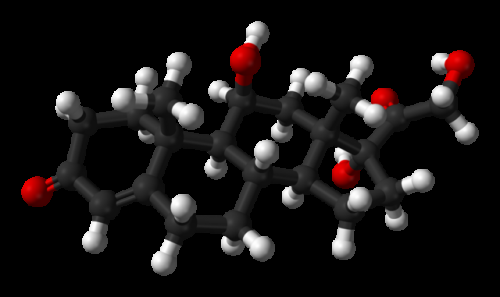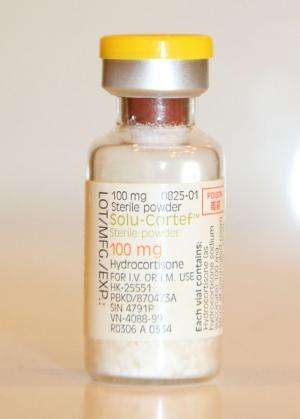Resurrected proteins, alternate histories and a sure path to modern physiology

Joe Thornton's business is resurrection. He doesn't bring back people, or pets, or even proteobacteria. Thornton specializes in the science of re-engineering long-gone proteins. His artful attempts to re-create the path by which we arrived in the present-tense have terminated with the following revelation: there is no other path to the here and now.
"If our results are general," said Thornton, Professor of ecology & evolution and human genetics at the University of Chicago, about his recent publication in Nature, "and we think they probably are – then many of our body's systems work as they do because of very unlikely chance events that happened in our deep evolutionary past."
Thornton and his colleagues have been reconstructing the sequences of ancestral proteins since 2001. In this June 2014 paper, Thornton describes the pains that he and Michael Harms took to recreate the modern Glucocorticoid Receptor (GR) from its 450 million-year-old progenitor, and what they discovered when they succeeded.
GR is a very common protein in today's world. It is found in every bony vertebrate. GR is the hormone receptor responsible for sensing the presence of cortisol. Cortisol itself is famous for something very modern. It is often pegged as the culprit in stress—the very powerful and extremely common psychological and biological phenomenon.
While taxing at times, stress—like taxes—is part of the cost of living. Human beings cannot physically survive without the stress response.
Cortisol and the stress response affect metabolism and development. They helps regulate the body's immune responses. This can be critical for survival. For example, people suffering from difficult-to-control asthma are in a state of too-much inflammation. To help cool off their hyperactive immune systems, these patients are regularly dosed with glucocorticoids, which bind to the GR receptor in much the same way as cortisol. On the other hand, the stress reaction, mediated by cortisol, can be harmful if prolonged. Overall, people who can't mobilize cortisol become critically ill. So like it or not, stress is here to stay as long as we are.
Given that we fought, fled and healed our way into our modern forms with cortisol in tow, it is reasonable to surmise that GR receptors evolved right along with us. In fact, we know that they did. In 2006, this same team discovered that two very specific mutations were required for GR to reach its current state. The first mutation didn't even affect the way the GR protein functioned. It did, however, make GR more robust. That first "permissive mutation", as it's called, allowed GR to later undergo a function-switching mutation that made it more sensitive to the presence of cortisol. The second required mutation was similar to the first. It didn't change GR in terms of function, but in terms of form GR was better prepared later on to be a good receptor for the stress hormone. That second permissive mutation, incidentally, was just as statistically unlikely and just as necessary as the first.

To find out how many evolutionary paths to these mutations exist, Thornton and colleagues took their resurrected GR—a little six-protein cluster that normally sits inside cell nuclei—to the library.
This "library screening" approach involved making a huge number of mutant variants of the ancestral GR that didn't work. These non-functional proteins were then allowed to be rescued by other mutations that might make them functional again. If a"rescuing mutations" allowed a GR protein in the library to function again, it was introduced back into our own ancestral GR protein to see it could restore GR to its moderns level of functionality. They did - or rather, one did.
Discover the latest in science, tech, and space with over 100,000 subscribers who rely on Phys.org for daily insights. Sign up for our free newsletter and get updates on breakthroughs, innovations, and research that matter—daily or weekly.
"In the library we found the historical permissive substitution," Thornton told Astrobiology Magazine. "We recovered the substitutions that actually occurred during history. But we didn't find any others despite searching through thousands and thousands of them."
To the question of, "How many evolutionary paths lead to modern GR?" the astonishing answer was, "One". Of all vast numbers of possible variants, only one particular set of mutations rescued our ancestral GR protein and brought it into its modern form. The only two mutations that actually succeeded are the same ones that we currently have.
"Among the huge numbers of alternate possible histories, there were no other permissive mutations that could have opened an evolutionary path to the modern-day Glucocorticoid Receptor," said Thornton.
The odds of this happening at random in the necessary order are astronomically small.
"If evolutionary history could be relaunched from ancestral starting points, we would almost certainly end up with a radically different biology from the one we have now," said Thornton. "This very important protein exists only because of a twist of fate."
At present, genetic events are largely unpredictable. By a twist of fate, or two, we all have functional GR receptors scattered by the billions within our bodies and lodged inside our brains.
The possibility that in no other scenario would things function quite as they do—as we do, as life does—today casts an interesting light on life on Earth and off it.
"If evolution is really dependent on these low-probability chance events that open up the pathways to new kinds of biological organization, then it means that it should be very hard to predict what the outcomes of evolutionary processes are likely to be," Thorton told Astrobiology Magazine, "And what forms life on other planets would actually take."
By trekking down alternative evolutionary GR paths and discovering that all but one led to a dead end, science may have started proving that life's current form is due to a series of fortunate events.
Journal information: Nature
Source: Astrobio.net
This story is republished courtesy of NASA's Astrobiology Magazine. Explore the Earth and beyond at www.astrobio.net .

















